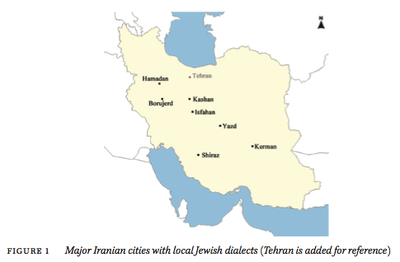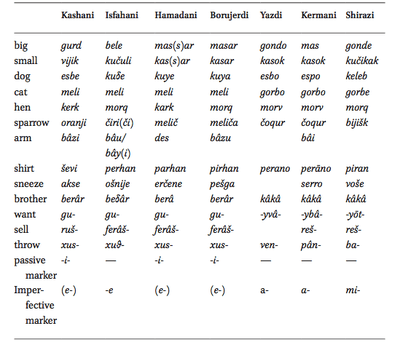Judeo-Hamedani dialect
The languages spoken by Iranian Jews are often lumped under the term "Judeo-Persian," a broad term that denotes the various forms of Modern Persian written in the Hebrew script. Native to Iranian Jews, it has also been used by Jews of Afghanistan, Central Asia, and the Chinese Jewish community of Ka'i Feng Fu. The original use of Judeo-Persian language is documented as early as sixth century B.C., however there are no literary documents that were preserved in this language prior to the eighth century A.D., according to Dariush Gitisetan from Brandeis University (Dariush Gitisetan, 13).[3] The separation of Jews from their native areas created linguistic differences, giving rise to many mutually incomprehensible dialects of Judeo-Persian. This is why, according to Habib Borjian, we need to separate Judeo-Hamadan from Judeo Persian(Habib Borjian, 117).[4] Judeo-Persian shares many features in common with Modern Persian, while still manifesting distinct differences. According to Gitisetan, these include(Dariush Gitisetan, 13)[3]
- The usage of loanwords from Hebrew, Arabic and Aramaic languages. This is the main difference, and therefore the reason why it is spoken by mainly Jews.
- Many spelling, phonetic, and syntax modifications.
- Conservation of many ancient Persian words, in addition to many archaic grammatical and phonetic features not found in Modern Persian.
- Wide usage of conversational style
| Judeo-Hamedani | |
|---|---|
| Judeo-Persian | |
| Dzhidi | |
| Native to | Iran, USA, Israel |
Native speakers | 8 (2001)[1] |
Northwestern Iranian
| |
| Hebrew script | |
| Language codes | |
| ISO 639-3 | – |
| Glottolog | jude1268[2] |
Judeo-Persian vs. Judeo-Median
Besides those languages categorized under Judeo-Persian, there are also several other spoken languages that belong under the Iranian stock of languages that are associated with Jewish populations in Iran. What Habib Borjian refers to as “Judeo-Median,” are a number of languages that have their center in central Iran and are/were spoken by the Jewry of Isfahan, Kashan, Yazd, and outlying western towns (Habib Borjian, 117).[4] All of these varieties are on the verge of extinction, both in their original motherland and around the world. While Judeo-Median is categorized from the Northwest part of Iran, it differs from Persian, a Southwest language, not only in location but also in vocabulary and grammar.
As explained before, beyond Judeo-Persian, there are other spoken Iranian languages used by various Jewish communities throughout Iran. These Judeo-Iranian languages can be classified into two groups. The first group belongs to the Southwest branch, just like traditional Persian, and consists of Bukhari, Juhuri, and Judeo-Shirazi. The second group consists of the Iranian languages spoken by the Jews belonging to the Northwest part of Iran. These dialects are part of a group loosely classified under the general designation of Central Plateau dialects (CPD's). Among this group are Khansar, Golpayegan, Khomeyn, Mahallat, and Delijan, which are located along the northwestern frontier of the CPD-speaking area. Further west are Hamadan Nehavand, Borujerd, Malayer, and Tuyserkan. The reason why Habib Borjian, along with many others, categorizes this group as part of Judeo-Median, is because of their location within the ancient province of Media (Habib Borjian, 119).[4] This group is native to a region in central Iran that extends roughly from Kashan in the north to Isfahan in the south. Mainly spoken in individual villages and small towns, Judeo-Median languages comprise a much smaller speaking group. Thus, in larger towns, it would be very common for those who spoke most of the Judeo-Median languages to transition to traditional Persian. This was in exception of the Jewish residents, who had tried to preserve the native languages until recently.
Judeo-Hamedani Classification

In western Iran, the district of Hamadan is split between Tuyserkan, Malayer, and Nehavand. This district along with Borujerd, further[4] south in Lorestan Province, form a geographic cluster that was inhabited by a good portion of Jewish communities until recently where those communities emigrated to Tehran, Israel, and North America. Already in 1701, Paul Lucas (cited by De Planhol 2003) wrote that Jews were more numerous in Hamadan than elsewhere in Persia. According to Encyclopedia Iranica, the Jewish community had dwindled from around 13,000 souls in 1920 to less than 1,000 by 1969.[6] It explains that according to members of the community that Donald Stilo encountered in 2001-02, there were only eight people from the Jewish community left in Hamadan at the time. It is hard to find people who still speak the language since only people born before the mid-1940s were raised speaking the dialect. As Habib Borjian points out, Hamadan was once the capital of Media, implying that a form of Median must have been spoken here before the arrival of Persian (Habib Borjian, 121).[4] Habib Borjian explains that these moribund dialects show closest resemblance to the dialects spoken in the areas of Qazvin and Zanjan, both north of Hamadan, and further northwest in Azerbaijan (Habib Borjian, 121). However, if we look at the historical arrangement of Jewish dialects of Hamadan, we see that it was originally native only to central Iran. This leads to the implication that only population movements from central Iran could have occasioned the presence of the Jewish dialects in the Hamadan area.
Judeo-Hamedani Grammar

If we look at the chart below, we can see how Judeo-Hamedani is compared to some of the other Judeo-Median Languages. We find it similar with Kashani, when it comes to passive and imperfective markers. We also find it united with Isfahani and Kashani with throw, want, and cat. With comparison to Isfahani, Judeo-Hamadani is similar with respects to dog. Within the same list we find Hamadani and Borujerdi further share the word sparrow. In terms of morphosyntax, although Hamadani is most similar to Kashani and Isfahani, the differences are sufficient to make mutual understanding quite low. According to Habib Borjian, “Tentative studies reveal that Tuyserkani agrees with Hamadani in all major grammatical points and lexical items (Stilo 2003), and that the dialects of Borujerd and Nehavand15 are close (Yarshater 1989)” (Borjian, 130).
See also
- Jews in Iran
References
- "In 1920, Hamadan had around 13,000 Jewish residents. According to members of the community that Donald Stilo encountered in 2001-02, there were only eight people from the Jewish community left in Hamadān at the time, but others can still be found in Israel, New York City, and most predominantly in Los Angeles."
- Hammarström, Harald; Forkel, Robert; Haspelmath, Martin, eds. (2017). "Judeo-Hamadani-Borujerdi". Glottolog 3.0. Jena, Germany: Max Planck Institute for the Science of Human History.
- Gitisetan, Dariush (1 January 1983). "JUDEO-PERSIAN LANGUAGE AND LITERATURE". MELA Notes (28): 13–16. JSTOR 29785197.
- Borjian, Habib (2014). "What is Judeo-Median and how does it differ from Judeo-Persian?". Journal of Jewish languages.
- Borjian, Habib (2014). "What is Judeo-Median and how does it differ from Judeo-Persian?". The Journal of Jewish Languages.
- "Hamadan".